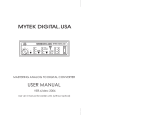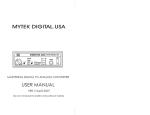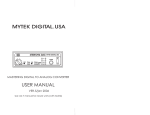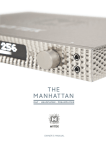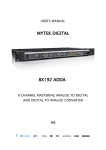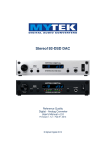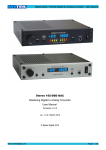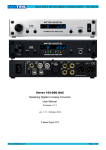Download MyTek Stereo 192 ADC User manual
Transcript
STEREO192 ADC MYTEK DIGITAL.USA 96 192192 TRIMPOTS SWITCHABLE L R 48 IN POT TRIM FS 88.2 SYNC 176.4 44.1 WCK /SUPERCK INT MASTERING ANALOG TO DIGITAL CONVERTER USER MANUAL VER. May 2006 Quick Start……………………………………………….3 Introduction..…………………………………….............4 This manual may be updated Operation- Internal jumper settings........................……...5 Download the newest version at: Operation- Typical setup -Balanced Signal Source……...7 http://www.mytekdigital.com/ Operation- Analog input alignment……………...………9 Operation- Unbalanced Signal Source…….......................10 For technical support, technical tips and support check: Sampling frequencies and External synchronization…....12 http://www.mytekdigital.com/ Rack mount shelf.......................................….....................14 or contact Mytek tech support at: Companion Stereo Series Converters………………….....15 [email protected] Specifications…………………………………………......17 Warranty conditions……………………………………...18 or at: tel. (646)-613 1822 fax.(212)-202 5331 Mytek 151 Lafayette Street 3rd Fl New York NY 10013 USA 1 2 Pot/Trim selector assigns either as the input sensitivity controls. They set input sensitivity with range from mute to +4dB=-6dBFS. Precision 10 turn trimpots allow for precise level alignment while the knob is intended for quick “on the fly” adjustments. Refer to "Alignement” for details. Sample rate selection. Sets the desired sample rate. When used with external clock select FS closest matching that of supplied external wordclock. Introduction to Stereo Series Converters Peak meter in -dBFS. The red LED marked "0" corresponds to 1 sample overload. The MYTEK Stereo series is an extended family of 1/3 rack units which includes 96 and 192kHz capable converters, SRC and Studio Clock. Stereo192 converters can be used as stand-alone devices for variety of studio applications such as mastering, recording and playback, whenever the highest quality conversion is required. Stereo192ADC is currently the world’s highest performance portable DC powered converter. STEREO192 ADC 192 TRIMPOTS SWITCHABLE L R IN POT TRIM FS 176.4 96 48 88.2 SYNC 44.1 Internal sync provides the best clock stability (10ps) and thus the best conversion. External sync is intended for complex systems. It can be a standard wordclock signal or Protools (tm) 256X superclock. Refer to "Internal jumper settings" for details. Since internal clock generator is top notch, there is no sonic benefit from clocking Stereo192ADC externally. The ultra stable ADC clock however is a great clock to drive other digital equipment. Line power is 115VAC/50/60Hz (factory default) or 230VAC/50/60Hz switchable by internal switch accessible after removing the top cover. 1 Amp slow blow 20mm fuse is also accessible under the cover. BAT WCK /SUPERCK INT Two LEDs measure battery status. They are lit with AC mains Wordclock input (factory default) can be set to alternatively accept 256 Protools (tm) Superclock (Mix systems). Refer to "Internal jumper settings" for details. 75 Ohm termination (default off) can also be set inside unit. Power switch only affects the AC mains. 115/230 VAC and fuse (type “T” or “slow blow”, 1A) is located under the unit’s lid) Analog inputs accept a range of signals from +4dB balanced down to consumer unbalanced. Refer to "Internal jumper settings" for details. Users choose Mytek converters primarily for their outstanding sound quality. The sound of Mytek converters can be described as "transparent". We design our converters to be as faithful to the signal as possible, rather than follow philosophy of some other manufacturers who offer "analog" or "tube" sounding converters. Mytek converters are closest to a straight wire, which is especially evident when used at full resolution. Sonically they are equal or better than the most expensive mastering converters. Stereo192ADC produces 20dB (10 times) less distortion than typical converters found in budget recording equipment. On Mytek website you can find and download various sound samples to evaluate Stereo series sound quality and compare it to the sound of other high end converter units. To download samples log onto: http://www.mytekdigital.com Stereo192 ADC features include: DC POWER 7-12 VDC Wordclock output provides high current drive and a very stable low jitter clock. It can be used as a superior house clock to clock or synchronize other digital equipment. Running Stereo96ADC on internal clock and slaving the rest of equipment to Mytek clock is the recommended setting for best sonic performance. - AES/EBU and SPDIF outputs are simultaneous. They operate in "single wire" mode for all sampling frequencies. These outputs can be used to externally clock other equipment with the same effect as wordclock output. Clocking via AES/EBU line is recommended especially when cables are very long (over 20ft). Battery jack accepts a 7-12 VDC battery for portable operation. There is no sonic compromise when using battery power. Power switch is only active with AC Power. Battery with lesser Voltage is recommended as its capacity will last longer. 3 - 44.1, 48, 88.2, 96, 176.4 and 192kHz internal sampling frequencies 24 bit resolution Ext. wordclock sync 25-100kHz or 256x Superclock(tm) 120dB Dynamic Range Switchable precision 10 turn-trimpots or input gain knob Wordclock output can be used as a hi-end house clock. 4 Stereo192ADC internal trimpots and jumper assignments (remove top cover to access) Stereo192ADC internal trimpots and jumper assignments (remove top cover to access) Jumper JP5: Wordclock input 75 Ohm termination. Connect this jumper when Stereo96 ADC is the last destination in a chain fed by external wordclock source and the cable is long (above 6ft). For short cables and wordclock sources with unknown drive capability JP5 should be left unconnected (unterminated) (retain the jumper on one pin only). DIPSWITCH SW4 : Sets the clock mode on BNC in/out SW1- "ON", wordclock =FS/2 for 88.2 and 96k (FS for 44.1 and 48k) SW1- "OFF", wordclock =FS for all sampling rates SW2- "ON", output and input becomes Superclock=256 x FS (for use with Protools(R) Mix systems and 44.1 and 48k only) 115VAC/230VAC power switch Jumpers J1 and J2- Set the input to unbalanced. The unbalanced signal should be fed between pin 2 (signal) and pin 1 (shield) of the input XLR. Pin 3 must be left unconnected. You can use a standard RCA<>XLR adapter, but make sure connection to pin 3 is cut inside the adapter. In this mode the sensitivity of the input stage is fixed and cannot be adjusted within the converter (adjust level prior to feeding the converter). This mode is recommended only in situations when no professional balanced signal source is available. This also works with -10dBV (consumer level). T1 Amp 20mm Slow Blow fuse 5 6 Typical Setup Balanced signal source Stereo192 ADC is equipped with 2 XLR analog inputs. For best signal to noise performance it is recommended the signal source has a typical low impedance output with standard +4dB line level balanced signal. Alternatively a weaker unbalanced signal source can be used as described in subsequent paragraph. In typical setup the ADC is running on its internal clock with the rest of equipment synchronized to Mytek clock either through digital output signal or wordclock. In this configuration Mytek ADC serves as a very stable low jitter house clock which increases the integrity and robustness of the rest of the system. Because of careful design this clock is as good or better than dedicated studio clock generators. Unlike in lesser quality equipment there is no sonic benefit in clocking Mytek ADC externally. In case of such operational need refer to "Sampling frequencies and external synchronization". Setup for typical balanced operation includes following steps: 1. Select either of input sensitivity controls: The wordclock source can be terminated with internal 75 Ohm resistor inside the Mytek unit (see: "Internal jumpers"). The termination is recommended when using long wordclock cables (above 10 ft) and when the wordclock source is capable handling such termination. Do not terminate if the source is not capable of high current drive or cable is short. 4. Select sampling frequency. If wordclock/superclock is used the sampling frequency has to correspond to external clock frequency (can be multiple, see: "Internal jumpers") 5. Synchronize the destination either to digital input sync or to wordclock sync, depending on system configuration. The quality of recorded signal does not depend on how the digital destination is synchronized with Mytek AD converter. 6. Record- adjust input level with knob or by adjusting level at the source. Unless you are printing final CD master, we do not recommend recording too hot. There is no sonic benefit of pushing the level up to 0dBFS. A healthy 1-2-3 dBs headroom allows more freedom in later processing and mixing of recorded tracks. The red peak light is triggered digitally when 1 or more samples are overload. It's not recommended to peak frequently although occasional overloads might be acceptable. a. Input knob - this mode is recommended for casual use where the input level is vaguely defined and needs to be quickly adjusted with input knob. or: b. Select precision 10-turn trimpots. Then perform "analog input alignment" as described in the next chapter. 2. Setup all other connections. 3. Select desired clock source (sync), either internal or external. If external wordclock or superclock source is required for systemic reasons, setup its mode using the DIP switch as described in "Internal jumpers". 7 8 Unbalanced Signal Source Operation Analog Input Alignment When using precision trimpots analog input level needs to be aligned using an approx 1kHz sinewave fed from +4dB balanced source. The alignment does not affect audio quality, only input sensitivity. The alignment is performed using 10 turn trimpots. A small tweaker or screwdriver is necessary. You have to arbitrarily decide what will be your studio "0 VU" analog/digital reference level. It is usually between -20 and -14dB. It defines how much headroom you have left over the normal operating "0 VU" level. You may set it at the same level as other piece of equipment in your studio. Some equipment is fixed at -18dB (which is low for most rock and roll recordings) but good for more dynamic classical. Some is fixed at -15dB which is a typical optimal level. Stereo192ADC can be operated with weaker consumer level unbalanced signal sources. Follow these steps in such case. 1. Unbalanced cable used to feed the unit must have signal connected to pin 2 of XLR, ground (shield) connected to pin 1 and while 3 must be disconnected. Wrong wiring of this cable can cause improper operation resulting in elevated distortion or noise. 2. Set the jumpers to "unbalanced" and disconnect both the trimpots and potentiometer. This sets the converter to its hights sensitivity (approx 10dB FS). 3. Setup all other connections. 1.Set the oscillator in your console at 1kHz and "0 VU". Send the oscillator to the ADC analog input."0 VU" at + 4dB corresponds to 1.225 Volts RMS measured between pin 2 and 3 of the output XLRs. If you do not have an analog oscillator, you can use a calibrated analog out of a DA converter and generate the sinewave inside the DAW. 4. Select desired clock source (sync), either internal or extrenal. If external wordclock or superclock source is required for systemic reasons, setup its mode using the DIP switch as described in "Internal jumpers". 2. Connect a digital PEAK meter to a digital output. If you don't have a dedicated digital meter use the most precise meter available in you existing digital recording equipment or DAW. The wordclock source can be terminated with internal 75 Ohm resistor inside the Mytek unit (see: "Internal jumpers"). The termination is recommended when using long wordclock cables (above 10 ft) and when the wordclock source is capable handling such termination. Do no terminate if the source is not capable of high current drive or cable is short. 3. Adjust the analog input level to get appropriate reading of the meter (for example -15dB). 4. Select sampling frequency. If wordclock/superclock is used the sampling frequency has to correspond to external clock frequency (can be multiple, see: "Internal jumpers") The alignment has to be performed with accuracy of 0.1dB to be considered accurate. Similar alignment procedure with 0.1dB accuracy is required for valid A/B listening comparisons btwn. different pieces of equipment. A slightly louder source is typically perceived as "better" sounding. 6. Synchronize the destination either to digital input sync or to wordclock sync, depending on system configuration. The quality of recorded signal does not depend on how the digital destination is synchronized with Mytek AD converter. 7. Record- adjust input level by adjusting level at the source. Unless you 9 10 Are printing final CD master, we do not recommend recording too hot. There is no sonic benefit of pushing the level up to 0dBFS. A healthy 1-23 dBs headroom allows more freedom in later processing and mixing of recorded tracks. The red peak light is triggered digitally when 1 or more samples are overload. It's not recommended to peak frequently although occasional overloads might be acceptable. Sampling frequencies and External Synchronization In typical setup the ADC is running on its internal clock with the rest of equipment synchronized to Mytek clock either through digital output signal or wordclock. In this configuration Mytek ADC serves as a very stable low jitter house clock which increases the integrity and robustness of the rest of the system. Because of careful design this clock is as good or better than dedicated studio clock generators. Unlike in lesser quality equipment there is no sonic benefit in clocking Mytek ADC externally. Mytek internal clock generator is situated within inches of converter chip and it will always provide a better jitter performance (approx 10ps) than any external source which is inherently compromised by cable connections. If external wordclock or superclock source has to be used for systemic reasons, the Stereo192ADC clock generator will lock to external source and use a stabilizing PLL circuit to reduce incoming clock jitter before it reaches the actual AD circuit. Stereo96ADC can be operated with any of 6 standard sampling frequencies or at any frequency btwn. 30k-200k when supplied with external clock source. The measurable audio band performance (Dynamic Range) stays virtually the same within all these frequencies. 44.1k will be typically used for printing final master. 48k is recommended for digital video production. The high sampling rates are recommended for discerning users requiring uncompromised sound quality. In this mode the ADC features up to 100kHz bandwidth (instead of 20k for 44.1k) which allows for improved transient response of recorded music as well as minimized the impact of brick wall antialiasing digital filters on the upper audio band. The end effect of hi-sampling recording is a more "analog feel" and easiness of sound and more natural sounding instruments especially percussion or cymbals. A decision of choice btwn. 88.2/176.4k or 96/192k should be made based on the project flow- there might be benefits for one or the other. 88.2k may convert to 44.1k with less damaging SRC process, if such process is available. Most ubiquitous software SRCs are not very good sonically 11 12 and must not be used for critical projects downsampling. Some such as Faulkner Downsampler (http://www.audiosignal.co.uk/freeware.html) provide excellent results for 88.2>44.1 but don't work for 96k. 88.2k is also easier to upsample to DSD. 96k sample rate, has in our opinion, a marginally better perceived sound quality than 88.2k but the difference is very small and difficult to perceive for most people. If the record is going to be mixed in analog domain, 96k might be a desirable choice for tracking. 13 Rack Mount Shelf The Stereo96 ADC is 1/3 rack space wide and 1U tall. Mytek provides a 1U rack mount shelf as accessory to mount up to 3 of 1/3 rack units. The units are attached to shelf with small screw connecting the shelf to bottom through a threaded hole on the bottom of the unit. 14 Companion Stereo Series Converters from Mytek this page will be updated 15 16 Warranty Specifications This Stereo192ADC digital audio converter is warranted by Mytek to the original purchaser against defects in workmanship and materials used in manufacture for a period of one year from the date of purchase. Faults due to customer misuse, unauthorized modifications or accidents are not covered by this warranty. Conversion: Linear, 128x oversampling at 44.1/48kHz 64x oversampling at 88.2/96/176.4/192kHz Resolution: 24 bit Sample rates: 44.1, 48, 88.2, 176.4, 192kHz or wordclock 25-100kHz Dynamic Range: 120dB THD+Noise: -106dB (<0.0005%) Internal clock jitter: <10picoseconds Analog Inputs: +4dBm balanced or unbalanced, 10kOhm Digital outputs: Hi-speed (25-200kHz) AES/EBU and SPDIF External Sync.: Wordclock in and out. or 256x Superclock Wordlock Out used as house clock: 15 LS TTL loads max. Can be terminated. Mains: 100/115V-220/240V 50/60Hz switchable Battery Power: 7-12 VDC Dimensions: 1/3 rack space wide x 1U high x 8” deep (5.5”x 1.6”x 8”) Weight: 4 pounds No other warranty is expressed or implied. Any faulty unit should be sent, shipping prepaid, to the manufacturer service center. Prior to shipping the client should obtain from Mytek an RMA# for warranty services. Units sent without RMA# will not be accepted. Mytek extends affordable repair service for all units manufactured to date that are not covered by this Warranty. 17 18











